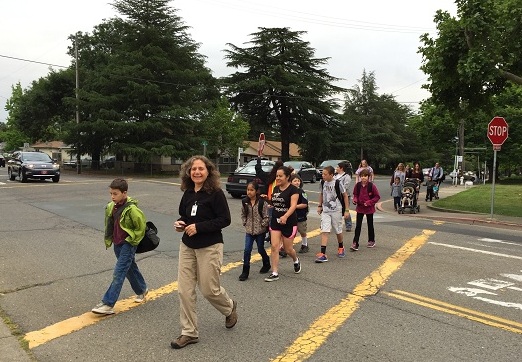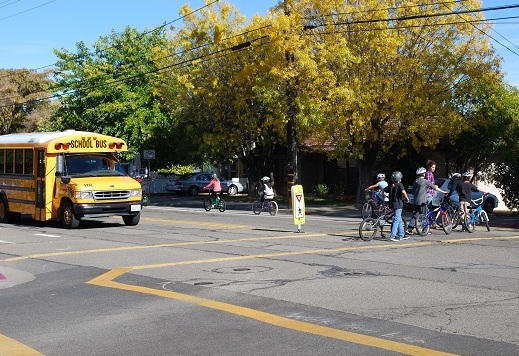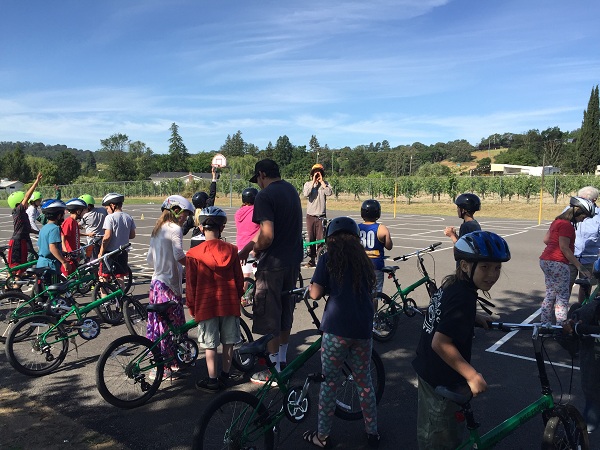

It’s that time of year again—schools are back in session. Although many children never want summer break to end, this is a great opportunity for parents to start new and healthy habits with their children. One way to achieve this is to walk and bike to school more often. That’s where the Safe Routes to School (SRTS) program fits in so well, especially at the beginning of the school year.
Established in 2006, SRTS programs are sustained efforts by parents, schools, community leaders and local, state, and federal governments to improve the health and well-being of children by enabling and encouraging them to walk and bicycle to school. Of course, increasing daily physical activity has many benefits. From overall better health, both mentally and physically, to reducing traffic and carbon emissions from our vehicles, more frequent walking and biking make communities stronger and healthier, not to mention happier. Being physically active with our family and friends, our neighbors and other community members creates a vibrant community.
Fortunately for those of us living in Mendocino County, a SRTS project is currently being developed to achieve these greater qualities of life here. The Mendocino Council of Governments (MCOG) received funding from the California Active Transportation Program to educate, train, and encourage students to walk or bike to school more often. It is supporting and developing SRTS programs countywide, thus increasing safety and helping to combat the negative health effects of physical inactivity. Working in conjunction with MCOG, the Health and Human Service Agency’s Walk and Bike Mendocino program is looking to implement a traffic safety education curriculum for many schools in our area. This project will provide educational training to both children and their parents on how to become confident pedestrians and riders. Walk and Bike Mendocino and its staff are working to demonstrate that walking and biking for daily trips are both convenient and beneficial to our health.
It is well known that our society has become more inactive. Compared to forty years ago, we now need to create healthy habits to move away from a sedentary lifestyle. Of course, the health of our children is a major concern. This decrease in activity is a major reason for the rise of childhood obesity, diabetes, and other health related issues. But this is a problem that can be easily fixed by making walking and biking part of our daily lives, as it was just a few decades ago.
Here are some statistics that prove this point:
- In 1969, 48 percent of children 5 to 14 years of age usually walked or bicycled to school (The National Center for Safe Routes to School, 2011).
- In 2009, 13 percent of children 5 to 14 years of age usually walked or bicycled to school (National Center, 2011).
- In 1969, 41 percent of children in grades K–8 lived within one mile of school; 89 percent of these children usually walked or bicycled to school (U.S. Department of Transportation [USDOT], 1972).
- In 2009, 31 percent of children in grades K–8 lived within one mile of school; 35 percent of these children usually walked or bicycled to school (National Center, 2011).
These are some alarming numbers displaying the decrease in daily walking and biking. Of course our lifestyle has changed since the late 60’s—the majority of both parents in a household now work full-time jobs, cities and towns have become more populated (meaning more vehicles passing by), and life in general seems to move at a quicker pace. Many people believe they simply don’t have the time to walk or bike with their children to school; but that’s a misconception. Just like anything else, we have to be willing to make time for physical activity, and it can be done.
Consider this: it takes approximately 17 minutes to walk a mile at regular pace, or about 5 minutes on a bike. How long does it take a parent to get their child in the car, drive to the school, and park? How long does a parent wait in their car in the drop-off or pick-up lane? How long does it take to get through after-school traffic? If it’s more than 17 minutes and you live within a mile or two from school, walking and biking might be great alternative to driving.
Cars are convenient, sure, but it may take just as much time, maybe even more, to drive your child to school. And what about the quality bonding time walking or riding a bike with your child would provide? Add to this the health benefits. If you live within a mile or two of your child’s school or your work, why not try to walk and bike for a day or two and see how it works out. See how little time it takes, and then see how much better you feel.
For additional information on Safe Routes to School Data check out this resource: http://saferoutespartnership.org/resources/report/srts-numbers
###
Joshua Landers, Field Coordinator for Walk and Bike Mendocino, is also an English instructor at Mendocino College. Originally from San Diego, he’s always been an outdoor enthusiast–surfing, bodyboarding, bicycling, and skateboarding. He is currently a member of the Mendocino Rugby Club, a published fiction writer, a husband, and a father to two children.

